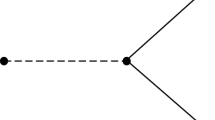Abstract
Social networks are often modeled by graphs, with nodes representing individuals and positively weighted edges representing the strength of the relationships between them. Working directly with such graphs is difficult, and it has become common to use spectral techniques that embed graphs in a geometry, and then work with the geometry instead. In a good embedding, edges that are heavily (positively) weighted, and so represent strong interactions, cause the vertices they connect to be embedded close to one another. However, in some social networks, there are also antagonistic relationships that are naturally represented by negatively weighted edges. The resulting graphs are called signed social networks. Clearly, an embedding of such a signed social network should place nodes connected by positively weighted edges close together, but nodes connected by negatively weighted edges far apart. Existing spectral techniques to embed signed graphs have serious drawbacks. We derive one unnormalized and two normalized spectral analysis methods for signed graphs and show, using real-world data, that they produce robust embeddings.












Similar content being viewed by others
References
Anchuri P, Magdon-Ismail M (2012) Communities and balance in signed networks: A spectral approach. In: Proceedings of the 2012 international conference on advances in social networks analysis and mining (ASONAM 2012), pp 235–242. IEEE Computer Society
Bühler T, Hein M (2009) Spectral clustering based on the graph p-Laplacian. In: Proceedings of the 26th annual international conference on machine learning, pp 81–88. ACM, Cambridge
Chiang K, Whang JJ, Dhillon IS (2012) Scalable clustering of signed networks using balance normalized cut. In: Proceedings of the 21st ACM international conference on information and knowledge management, pp 615–624. ACM, Cambridge
Chung F (2005) Laplacians and the Cheeger inequality for directed graphs. Ann Comb 9(1):1–19
Davis JA (1967) Clustering and structural balance in graphs. Hum Relat 20:181–187
Dhillon IS, Guan Y, Kulis B (2007) Weighted graph cuts without eigenvectors a multilevel approach. IEEE Trans Pattern Anal Mach Intell 29(11):1944–1957
Doreian Patrick, Batagelj Vladimir, Ferligoj Anuska (2005) Generalized blockmodeling, vol 25. Cambridge University Press, Cambridge
Fiedler M (1973) Algebraic connectivity of graphs. Czechoslov Math J 23(2):298–305
Gleich DF, Seshadhri C (2012) Vertex neighborhoods, low conductance cuts, and good seeds for local community methods. In: Proceedings of the 18th ACM SIGKDD international conference on knowledge discovery and data mining, pp 597–605. ACM, Cambridge
Grover A, Leskovec J (2016) node2vec: Scalable feature learning for networks. In: Proceedings of the 22nd ACM SIGKDD international conference on Knowledge discovery and data mining, pp 855–864
Hage P, Harary F (1983) Structural models in anthropology. Cambridge University Press, Cambridge
Hagen L, Kahng AB (1992) New spectral methods for ratio cut partitioning and clustering. IEEE Trans Comput-Aided Des Integr Circuits Syst 11(9):1074–1085
Harary F (1953) On the notion of balance of a signed graph. Mich Math J 2(2):143–146
Kannan R, Vempala S, Vetta A (2004) On clusterings: good, bad and spectral. J ACM (JACM) 51(3):497–515
Kunegis J, Schmidt S, Lommatzsch A, Lerner J, De Luca EW, Albayrak S (2010) Spectral analysis of signed graphs for clustering, prediction and visualization. In: SDM, vol 10, p 559. SIAM, New York
Leskovec J, Faloutsos C (2006) Sampling from large graphs. In: Proceedings of the 12th ACM SIGKDD international conference on knowledge discovery and data mining, pp 631–636. ACM, Cambridge
Leskovec J, Huttenlocher D, Kleinberg J (2010) Signed networks in social media. In: Proceedings of the SIGCHI conference on human factors in computing systems, pp 1361–1370. ACM, Cambridge
Leskovec J, Lang KJ, Dasgupta A, Mahoney MW (2008) Statistical properties of community structure in large social and information networks. In: Proceedings of the 17th international conference on world wide web, pp 695–704. ACM, Cambridge
Marineau JE, Labianca G, Kane GC (2016) Direct and indirect negative ties and individual performance. Soc Netw 44:238–252
Meila M, Pentney W (2007) Clustering by weighted cuts in directed graphs. In: Proceedings of the 7th SIAM international conference on data mining, pp 135–144. Citeseer, New York
Newman MEJ, Girvan M (2004) Finding and evaluating community structure in networks. Phys Rev E 69:026113
Ng AY, Jordan MI, Weiss Y (2002) On spectral clustering: analysis and an algorithm. Adv Neural Inf Process Syst 2:849–856
Perozzi B, Al-Rfou R, Skiena S (2014) DeepWalk: online learning of social representations. In: Proceedings of the 20th ACM SIGKDD international conference on knowledge discovery and data mining, pp 701–710
Walther O, Zheng Q, Skillicorn DB (2015) Signed directed social network analysis applied to group conflict. In: IEEE international conference on data mining, intelligence and security informatics workshop
Read KE (1954) Cultures of the central highlands, new guinea. Southwest J Anthropol 10:1–43
Shi J, Malik J (2000) Normalized cuts and image segmentation. IEEE Trans Pattern Anal Mach Intell 22(8):888–905
Spielman DA, Teng SH (1996) Spectral partitioning works: Planar graphs and finite element meshes. In: 37th Annual symposium on foundations of computer science, pp 96–105
Traag VA, Bruggeman J (2009) Community detection in networks with positive and negative links. Phys Rev E 80(3):036115
Trenkler G (1997) Handbook of matrices: Lutkepohl H (1996) Wiley, New York, xvi + 304 pp, ISBN 0-471-96688-6; [pound sign] 50.00. Comput Stat Data Anal 25(2):243
Von Luxburg U (2007) A tutorial on spectral clustering. Stat Comput 17(4):395–416
Walther O, Leuprecht C (2015) Mapping and deterring violent extremist networks in North-West Africa. Technical report, University of Southern Denmark, Department of Border Region Studies Working Paper 4/15, 2015
Yang B, Cheung WK, Liu J (2007) Community mining from signed social networks. IEEE Trans Knowl Data Eng 19(10):1333–1348
Author information
Authors and Affiliations
Corresponding author
Additional information
Publisher's Note
Springer Nature remains neutral with regard to jurisdictional claims in published maps and institutional affiliations.
Rights and permissions
About this article
Cite this article
Zheng, Q., Skillicorn, D.B. Modeling signed social networks using spectral embedding. Soc. Netw. Anal. Min. 11, 13 (2021). https://doi.org/10.1007/s13278-020-00718-8
Received:
Revised:
Accepted:
Published:
DOI: https://doi.org/10.1007/s13278-020-00718-8




